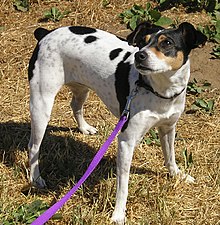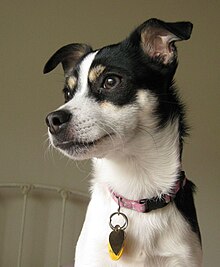Rat Terrier
The Rat Terrier is an American dog breed with a rich and varied background as an all-around farm dog and hunting companion.[1] Traditionally more of a type than abreed, they share much ancestry with the tough little mixed-breed dogs known as feists. Several private associations have maintained Rat Terrier registries for some decades, but more recently there have been movements to obtain breed recognition by the major canine organizations. Once common throughout America on family farms in the 1920s and 1930s, they are generally considered a rare breed.[2] Today's Rat Terrier is an intelligent, active little dog that is cherished both for pest control and as a family pet.
Appearance
The Rat Terrier comes in a variety of coat colors and sizes. The classic coloring is black tanpoint with piebald spotting (known as black tricolor), but chocolate, tan (varying in shade from pale gold to dark mahogany), blue, isabella (pearl), lemon and apricot are all fairly common. They may be tricolor or bicolor, always with some amount of white present. Sable may overlay any of these colors. Creeping tan (often "Calico"), is also acceptable. Ticking is usually visible in the white parts of the coat, or in the underlying skin. Brindle, currently disallowed by the main breed standards, is considered by some to be a traditional Rat Terrier pattern, and there is a growing movement to have this pattern accepted into the breed. However, merle is widely considered to be the result of recent outcrosses and, because of associated health problems, is rejected by most Rat Terrier breeders.
Ear carriage is erect, but can also be tipped, or button, all of which contribute to an intelligent, alert expression. The tail has been traditionally docked to about 2–3 inches, but the bobtail gene is very common in Rat Terriers and can result in a variety of tail lengths. Today, some breeders prefer a natural, undocked tail, which is accepted in the breed standards.
The Rat Terrier ranges from about 10 to 25 pounds and stands 13 to 18 inches at the shoulder. The miniature size (13 inches and under as defined by the UKC) is becoming increasingly popular as a house pet and companion dog. A larger strain, often in excess of 25 pounds, has been developed. These Deckers or Decker Giants were named after breeder Milton Decker who created a larger hunting companion and are recognized by the National Rat Terrier Association (NRTA, see Breed recognition below). The NRTA recognizes a Toy Variety weighing 10 pounds or less. Both the NRTA and the UKCI continue to classify the Teddy Roosevelt Terrier as the Type B Rat Terrier. In the 1970s, a hairless mutation appeared in a single Rat Terrier and was propagated into a strain of the Rat Terrier. After a period of development this line resulted in the American Hairless Terrier, recognized as a separate breed by several registries.
Temperament
Although often mistaken for a Jack Russell Terrier, the Rat Terrier has a different profile and a very different temperament. Rat Terriers are sleeker in musculature, finer of bone, and have a more refined head. They always have a short single coat, i.e., they are never wire coated.
Rat Terriers tend to be less aggressive than Jack Russells; while they have a definite terrier personality they also have an "off switch" and love lounging on the sofa in a lap as much as tearing about the yard. Rat Terriers are normally cheerful dogs, and they tend to be calmer and more sensitive than Jack Russells to changes in their environment, owner's moods, or to unexpected noises, people, and activities. The "social sensitivity" of Rat Terriers makes them very trainable and easier to live with for the average pet owner, but it also means that extensive socialization from an early age is critical. Proper socialization of a Rat Terrier puppy includes exposing the animal to a wide variety of people and places, particularly during the first three months of life. Like most active and intelligent breeds, Rat Terriers tend to be happier when they receive a great deal of mental stimulation and exercise.
History
The earliest record of a rat-catching dog is probably that of "Hatch", whose remains were recovered from the Mary Rose, the flagship of Henry VIII, sunk in 1545 and re-raised in 1982. Hatch is thought to have been a mongrel, and was brought on board to control the rat population.[3]
The breed name comes from the occupation of its earliest ancestors brought to the US by working class British migrants as these quick, tough little dogs gained their fame in rat pit gambling. However they were, for the most part, bred for speed. Their speed is used for controlling vermin and hunting squirrels, hare, and other small game. Like all terriers of this type, Rat Terriers most likely developed from crosses among breeds like the English White Terrier, Manchester Terrier, Smooth Fox Terrier, and Whippet. After the 1890s, as the breed type became popular in America, other breeds were added to the mix. Beagle, Italian Greyhounds and Miniature Pinschers,. Many of the foundation Rat Terriers were indistinguishable from small mixed-breed hunting dogs known as "feists". The smaller varieties were split off from the Rat Terrier very early on, registered by the UKC as the Toy Fox Terrier beginning in 1936.
Rat Terriers were cherished as loyal and efficient killers of vermin on 20th century American Farms, as well as excellent hunting companions. As a result they were one of the most popular dog types from the 1920s to the 1940s. However the widespread use of chemical pesticides and the growth of commercial farming led to a sharp decline in the breed from the 1950s onwards. Fortunately breed loyalists maintained the bloodline, leading to the modern Rat Terrier we enjoy today.
The genetic diversity of the Rat Terrier is undoubtedly its greatest asset, and is responsible for the overall health, keen intelligence, and soundness of the breed. Most modern breeds were developed from a few founding dogs and then propagated from a closed gene pool. In contrast, the Rat Terrier has benefited from a long history of refinement with regular outcrosses to bring in useful qualities and genetic variability.
 | ||||||||||||||||
| Tricolor Rat Terrier; note pale black ticking on white coat | ||||||||||||||||
| Other names | American Rat Terrier Ratting Terrier Decker Giant | |||||||||||||||
|---|---|---|---|---|---|---|---|---|---|---|---|---|---|---|---|---|
| Nicknames | RT, Rat, Rattie | |||||||||||||||
| Country of origin | United States of America (USA) | |||||||||||||||
| ||||||||||||||||
| ||||||||||||||||



No comments:
Post a Comment